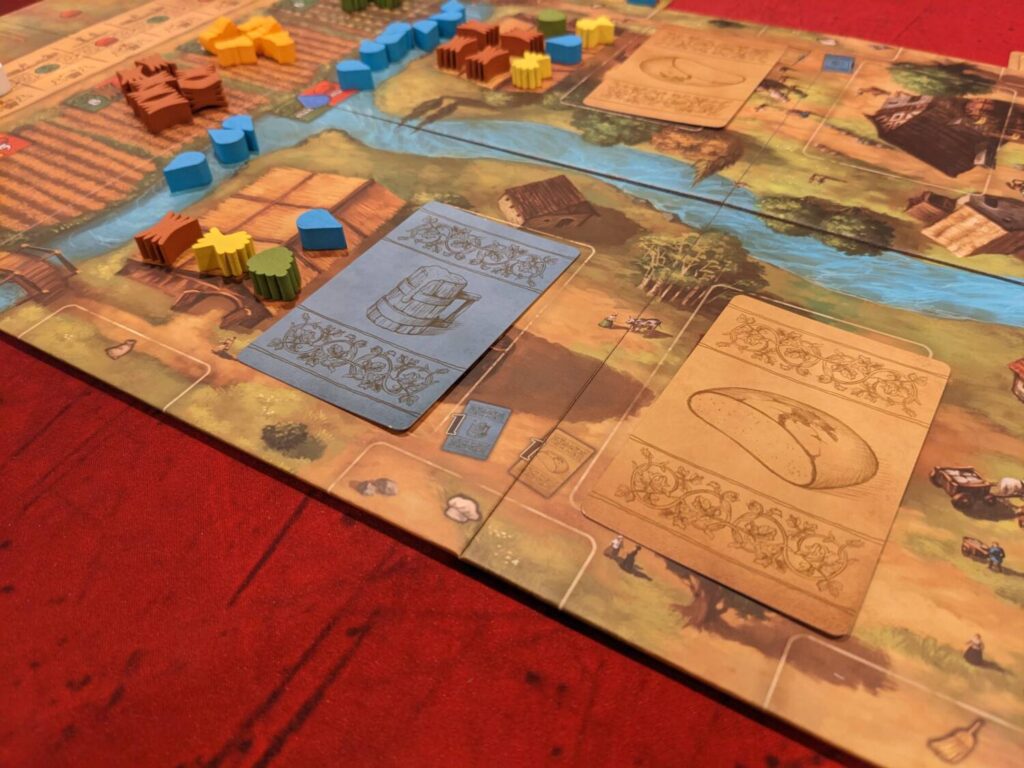Designer Scott Almes is best known for his Tiny Epic _____ series of games, published under his Gamelyn Games label. The Meeple Mountain team has reviewed about five of them, and we’ve generally thought of those games as OK—nothing incredibly special, but nothing incredibly bad either.
Then I reviewed Roller Coaster Rush, another Almes design, and that might have been the worst game I played in 2023. Legitimately terrible. So, based purely on recency bias, I was a little apprehensive when I opened the box for his 2022 release Beer & Bread, published in the US by Capstone Games.
Almost immediately, those fears vanished. Had Beer & Bread hit my table in 2023, I probably would have named it my favorite two-player-only game, just edging out Sky Team. It’s that good.

A Little of This, But Not More of That
My appreciation for Beer & Bread starts with the scoring system. A bit like Between Two Cities, Ark Nova, Tigris & Euphrates, and other classics, Beer & Bread is a race to score points by fulfilling orders on two different sets of cards, beer cards and bread cards. The lower of the two scores ends up as a player’s final score, so a balancing act is key to victory.
Each player represents a nameless village just over the stream from a rival village. During a six-year period, the villages will conduct a friendly competition to see who can produce the most beer and bread. Each year is a round, and each round is simple. With a hand of five cards, players must use a card for one of its three functions.
- Harvest and Store, which produces one of the game’s five resources to be stored in a nine-space warehouse
- Produce and Sell, an order fulfillment function that requires a player to spend 4-7 resources to score a card
- Upgrade and Clean, requiring a player to tuck the card under certain sections of their side of the board to have an ongoing or end-game power. This also allows scored cards to be moved out of the bakery and/or brewery to be scored at the end of the game.
In odd-numbered rounds, players will play one card each, then swap hands. In even years, players will keep previously-played Harvest and Store cards and add new cards to their hand in order to have new options to play.

Beer & Bread immediately became one of my favorite multi-use card games because the card options are usually so tricky. Across three plays—once with a very seasoned gamer, once with my wife, and once with my nine-year-old daughter—I was surprised how often I was torn between two, or even three, of the options on a card before making a choice. Still, that didn’t slow the game considerably, with all of my plays taking less than 30 minutes.
The card system is so smooth. The Harvest and Store action stacks, so if I play a second card for the Harvest and Store action, I get all the resources on both of the cards in my tableau. That means that you can fill up your warehouse fast, and if you’ve got a nice variety of the five resources (water, wheat, barley, rye, and hops), you can usually fulfill a card in the Produce and Sell step a couple times each round.
I love that the upgrade system is unlimited. Some of the upgrade cards align with end-game points, and they can be great for setting a strategy early in the game. I also love that this is aligned with the “Clean” action. By limiting storage of fulfilled cards to one each of both beer and bread, it pushes players to use upgrades strategically while also helping build a production engine or adding to end-game scoring.
The teach was easy, and the back of the rulebook serves as a shared player aid. The box is small—not Tiny Epic small, but still quite tidy—and the rules even provide an overly-detailed description of each card upgrade, even if I felt that was unnecessary. If you don’t want to read the rules, there’s a seven-minute video that is linked to on the box.

Essentially Flawless
Beer & Bread is fantastic. Easy to learn, easy to table, and plays in a half-hour. I can play it with gamers, I can play it with non-gamers. Each game will play out a little differently, and the upgrade system allows for players to tailor the experience however they like over the six rounds of play.
My only issue, and it is admittedly a nitpick: hops, the green resource in Beer & Bread. Hops only appear as a recipe requirement on 19 of the game’s 60 cards (only on beer cards, and yes, I counted). In all three of my games, it never seemed like I needed hops. That’s because the other 11 beer cards don’t require hops, and rather than wasting a Harvest and Store action on a card that has hops, I’m going to get nearly anything else. That way, I have the ultimate flexibility when it comes to storing items that could be spent against beer AND bread cards, not just beer cards.
Beyond that? I thought Beer & Bread was a perfect two-player-only game. It doesn’t knock 7 Wonders Duel off the throne, but Beer & Bread is really good and immediately becomes the best Scott Almes design I have tried. I’ll be keeping this around for plays with my family!












Add Comment